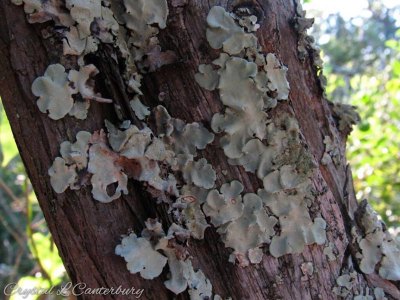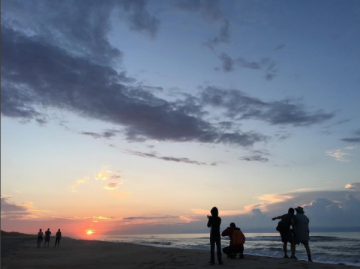Shooting Ocracoke
Amateur and professional photographers alike joined in an exciting series of events which took place on Ocracoke this week. A team of photojournalists from National Geographic visited our tiny island as part of the Beautiful Destinations series, and to promote and get people engaged in NatGeo's online community Your Shot. Monica Corcoran, who has been visiting Ocracoke for 30 years, and Matt Adams, who celebrated his one-year anniversary with National Geographic this week, came down from the Washington, D.C. office along with freelance photographer David Y. Lee. Also joining in the photowalks was Oleg Litvinenko, a traveler and photographer based out of Washington, D.C., who is a Your Shot community member and was coincidentally on Ocracoke.

So, how does one become a photojournalist for National Geogaphic? Monica studied Political Science and Studio Art at Hollins University where she earned a Bachelor's degree. Matt completed his undergraduate degree in photojournalism from Point Park University before completing a Master's degree in Visual Communiction from Ohio University. David studied English at University of North Carolina, Chapel Hill, where he earned a Bachelor's degree, then went onto complete a Master's degree in Visual Communications from Ohio University. Monica also explained that many National Geographic photojournalists came from different paths and experiences. She said sometimes photojournalists will spend years on a project, making them longterm storytellers. Others are illustrators and map makers, and some come into National Geographic as assistants or interns, but they are all hard working people who are "wonderful and amazing."
The team that visited Ocracoke is working on the Beautiful Destinations and Your Shot programs. Destinations are chosen in a variety of ways. Many of the spots this year coincide with the centennial of the National Park Service, which is being celebrated at Parks across the country. Other times special events, such as cultural festivals, take the team on new adventures.

The Your Shot project was first introduced in 2006 by then-Editor Chris Johns, who was the first photographer to be in that position. Initally, one page in each publication asked readers for photo submissions. The images were sent in via email, then uploaded. In 2013, Monica relaunched Your Shot, and did so from Ocracoke Island. Beginning the same year, users were able to chat with each other, which really began to form the online photo community. Now, Your Shot is an extensive online community that allows anyone to upload photographs, add hashtags to social media, and engage with other photographers for tips and support.
Your Shot can be used by anyone and, "is a very supportive community. It's a big deal to upload your image to NatGeo," explained Monica, "and the community is helpful and offers great feedback." Matt continued, explaining how Your Shot is great place to share "tips on how to be a better photographer and story-teller."
Each day, Matt looks through anywhere between 5,000 and 8,000 photos. He chooses images from that group which are then sent to Your Shot Photography Producer Jeanne Moddermann. Next, she selects 12 photos from that group, which are called The Daily Dozen. These photos will be published monthly, spotlighting Your Shot photographer submissions. Now, Your Shot members may have the opportunity to meet the team and get some professional pointers!

Last week, many people got to have an in-person National Geographic photo session with the Your Shot team by joining them on photowalks and sessions around the island. I attended a 5:30am sunrise session where we got to meet the team, other photographers, and were sent on our way. The self-guided photosession allowed photographers to capture any images they wanted as the sunrise brightened the coastline, while seeking any advice from Monica, Matt, David, and Oleg. David, who accompanied Monica and Matt to capture images of the events, brought yellow borders from the National Geographic logo, which attendees used for a variety of poses. At the end of the event, Oleg wrangled everyone together for a group photo.
The same evening I attended the sunset photowalk through Springer's Point where we were encouranged to notice the fine details along the way. As the walk to the water takes us through maritime forest, there were plenty of details to spot. Leaves, lichen, plants, insects, shells, and roots caught the eyes of many of the photographers, as did the way the evening sun came through the trees and lit up the leaves.

Out along Teach's Hole, the attendees were wading in the water and exploring the Sound-side nature. Some folks saw a small sting ray swimming by the jetty; friends Jaymie and Amy found a sizeable hermit crab and were taking photos. They let me butt-in to snap photos of it too, and waited and so I could capture images as it slowly emerged from its shell. Participants sought advice from the NatGeo photographers, and everyone seemed to be having a blast.
Again, David brought the yellow borders which provided much fun to the participants. Later, Oleg wrangled the group – this one much larger than the morning group – and took snapshots of us along with local photographer Melinda Sutton. Positioned up a dune and around the tree, we squeezed together and managed to follow directions fairly well. The events planned and hosted by the NatGeo team were all casual, fun, and welcoming.

During their time here, Monica, Matt, and David also got to experience Ocracoke. I asked them to describe an image they would capture of Ocracoke – other than the lighthouse – they feel would represent what the island means. Monica loves to photograph Silver Lake because, "it's kind of the heart of the island." About relaxing on Ocracoke she said, "If I'm going to go somewhere on Ocracoke for six hours it's going to be South Point." Matt spoke about capturing an image of a true local who represents Ocracoke history. He agreed with Monica that South Point is a great spot to spend a beach day, but, as the sun set during our conversation, he said, "I really like the campground."
David, who joined the team to document moments during the sessions, is currently working on a project called The Waiting List. The project, which he works on between assignments, highlights how people can be affected by organ donation. His goal is to get people to care and to make organ donation more human. He said sharing this project online is "a powerful, more productive way to use social media, and it's a way to advocate." He explained that people share their stories with him, which he then shares through photographs and a written summary of each person's experience. About the NatGeo Your Shot program, Lee said, "It's exciting! Social media can be a fun way to share an experience! The Your Shot community is awesome!"
Visit the website and sign up to become a member of the Your Shot community today! It's a free and exciting way to share your world!

The Current welcomes contributions of photos for our Best Shots page. We love to share the beauty of Ocracoke with our readers! Send your Best Shots to ocracokecurrent@gmail.com and tell us a little bit about yourself and where/when you took them. Be sure to let us know if you took part in the Nat Geo Your Shot photowalks! Please note: we can only use horizontal photos for the front page!




